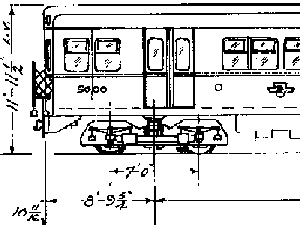
|
|
Click on the diagram above to see a full plan and diagram. |
By James Bow, revised by Robert Lubinski
Decades after the first proposals for underground “tube” railways traversed by streetcars, on January 1, 1946 the voters of Toronto approved the TTC’s proposal to build a rapid transit system under Yonge Street, the city’s principal north-south thoroughfare. Construction commenced in September 1949, and the TTC initiated its search for the right equipment for its new rapid transit line.
Original proposals called for a vehicle based on the technology of the PCC streetcar. The car would be of similar dimensions and use the same propulsion equipment and trucks. The TTC even built a full-size mock-up car of its preferred design at its Hillcrest Shops. In 1951, the TTC called for tenders from prominent car builders in North America, notably the St. Louis Car Co. and Canadian Car & Foundry Co. The prices quoted were deemed to be “unreasonable” by the TTC, and due to the materials constraints caused by the war in Korea, procurement of supplies meant the timing of delivery could not be guaranteed. The TTC then widened its search to include builders from the United Kingdom, France and Belgium.
Eight car builders tendered several bids, and one of them was of particular interest to the TTC. One of the proposals put forward by the Gloucester Railway Carriage & Wagon Co. was for a longer car than the TTC had originally conceived. The primary benefit of a longer car was a reduction in equipment cost. A train of eight 57-foot cars needed fewer control packages, trucks, couplers, etc. than a ten-car train of 48-foot cars. The savings in equipment amounted to approximately $1.5 million CAD at the time. The passenger capacity of a full-length train would be nearly the same, and the relative lack of tight-radius curves on the Yonge Street Subway meant that longer cars could be easily accommodated. In addition, the United Kingdom Trade Commission gave the strongest assurance that materials would be made available for the TTC cars, in order that a delivery date by the end of 1953 (the expected opening of the rapid transit line) could be met. North American car builders, constrained by the materials allocation imposed by the Korean War and much more unfavourable trade tariffs for equipment imported from the USA, could not match the cost and delivery date of the Gloucester bid.
TTC staff, including the General Manager, visited the bidding car builders, and were very impressed with the quality of the ride and comfort found on Gloucester-built cars operating on the London Underground. While the merits of PCC technology for rapid transit cars were a logical evolution from the PCC streetcar, the TTC felt that it was not evolved enough to meet its needs compared to the product offered by Gloucester. This combined with the substantial capital cost savings arising from a longer car and delivery assurances persuaded the TTC that it should award the tender to Gloucester.
The order for the newly-christened “subway” cars was approved on November 19, 1951 for 104 cars at a total approved cost of $7,800,000, which included freight, insurance, sales taxes and a quantity of spare parts. Construction proceeded smoothly until the weigh-in of the first completed cars. The cars tipped the scales at 40% in excess of their estimated weight. The cars weighed 85,525 lbs compared to the estimate of 60,900 lbs. Some quick calculations revealed that the traction system could handle the higher weight, but modifications had to be made to the braking system to compensate for the additional load. Some hasty weight reduction measures were able to bring the total weight down by a full ton, but only after the first 30 cars were already substantially constructed on the assembly floor. This grave weight miscalculation would dog the cars for their entire operating life.
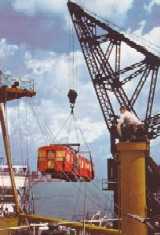
|
|
Unloading first subway car from Britain at Port of Montreal. |
The first two Gloucester cars were shipped from England to the port at Montreal. They were then carefully brought by rail on the CNR to Toronto on specially modified flat cars. They were delivered to Hillcrest on July 30, 1953 and after unsealing and inspection, the two cars were towed along temporary track to the north side of the Hillcrest property for inspection by TTC management and the press. During August, “Brill” streetcar trucks were placed under the cars, and they were towed down Bathurst Street to the Exhibition. There, they were moved again via temporary track to a display location and placed back onto their Gloucester trucks. Between August 28 and September 12, 1953 CNE visitors could board the cars from a mock-up subway station, which included a proper entrance, platform, track and signal display. The display was a huge success as Torontonians eagerly awaited the opening of their “ultra-modern” subway.
After the Exhibition closed, the cars were once again placed atop streetcar trucks and towed at night by Peter Witt streetcars to the new Davisville Subway Yard via Bathurst St, St. Clair Ave and Yonge St. Unfortunately the leading car, 5001, derailed on the temporary track connection between the Yonge St. and the yard. It took the remainder of the night to re-rail it. In order to make way for the regular streetcar service, car 5000 had to be stored for the day at the Lawton Loop (now a small park), down the street from the yard. A watchman supervised the car for the day until the following night when it was moved into the yard without incident.
Car deliveries began in earnest by this time with the rest of the cars being delivered directly to the Davisville Yard using the Canadian National Railway’s Belt Line (now a popular walking trail stretching from the Mt. Pleasant Cemetary north-west to beyond Eglinton Ave). The subsequent deliveries followed the same pattern as the first, with the cars being unloaded at Montreal or Halifax, and then shipped by rail to Toronto. Deliveries continued through late 1953 and early 1954, and were completed exactly to the schedule promised by Gloucester.
The first powered test run on the Yonge Subway was completed by cars 5004 and 5005 on September 20, 1953. They operated under their own power from Davisville to Bloor Station amid much fanfare and excitement. In October a second test trip was made to test tunnel clearance in the section of the subway from Bloor to Union Station.
Motorman and Guard training commenced in early 1954, and by opening day, some 200 men had been trained for subway operations. As the weary old Peter Witt trains crawled up Yonge Street one last time on the afternoon of March 29, 1954, Toronto commuters excitedly awaited their first ride on the spacious and shiny new red subway trains.
On March 30, 1954 the Yonge Subway officially opened with cars 5092-5099 comprising the official first train, and the subway era began in Toronto. Toronto commuters quickly embraced the subway and ridership rapidly surpassed initial expectations.
Prior to the completion of the 104 cars, the TTC changed the specifications of the last four cars, so that they would be constructed of aluminum bodies instead of the steel used on the rest of the cars. The possibility of using the more lightweight metal for rapid transit cars was advanced by the Aluminum Development Association in the UK, which promoted the potential energy savings and weight reduction offered by using aluminum in place of steel for body construction. The development costs were absorbed by the ADA, and together with Gloucester, they drafted engineering designs for the aluminum car. Initial estimates revealed a weight saving of 6 tons from a steel-bodied car, with power consumption reduced accordingly. The cars would be finished in a plain aluminum finish, with distinctive striping to accentuate their striking appearance.
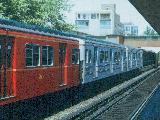
|
|
G2 ‘White Gloucesters’. Photos donated by Brad O’Brien. |
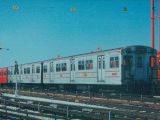
|
In order to maximize the benefits of the aluminum cars, in June 1954 the TTC ordered two additional aluminum cars to make up a complete six-car train, which could be operated on its own during regular service. With subway ridership higher than estimated, six-car trains were being used for base service. The first four aluminum cars (designated the “G-2” class and numbered 5100-5103) were delivered by the end of 1954, while the two additional cars (5104-5105) arrived in the spring of 1955. The benefits of the aluminum cars were obvious — power consumption was lower than that of the steel G-1 class cars, and because of its lighter weight, the aluminum train was faster. The success of the aluminum Gloucesters led to the adoption of aluminum as the standard for light-weight rapid transit cars in the future in Toronto.
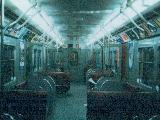
|
|
Gloucester with fluorescent lighting. Photo donated by Jim Blair. |
With ridership exceeding all expectations, in May 1955 the TTC experimented with operating full-length eight-car trains. The increase in passenger capacity of 33% significantly eased peak period crowding. As ridership projections showed continued growth, the TTC faced a shortage of subway cars by the end of 1956, years ahead of original expectations. With the existing fleet being used at over 90% utilization on a daily basis, there was no further ability to increase passenger capacity. As a result, the TTC tendered for 34 additional subway cars to supplement the existing fleet.
In order to reduce cost and weight and based on favourable experience from other subway systems, the new cars would be “non-driving motors”, meaning that there were no driving controls in the cab (which was maintained for use by the subway guard), and no automatic couplers. The supplemental cars would be inserted between a pair of existing cars to produce a four-car semi-permanently coupled train. Fleet capacity would be increased by one-third, and would provide enough passenger capacity to meet the maximum flow of 40,000 passengers per hour that had been envisioned for the Yonge Subway. The TTC once again sought tenders from several car builders, with the requirement that the cars be fully compatible with the existing Gloucester cars.
Gloucester proposed both aluminum and steel cars, with steel cars being the most economical, although to reduce weight, aluminum was prominently used in the design for the roof and other components. Once again, the Canadian Car & Foundry Co proposed a PCC-type car. This design was the same length as the Gloucester car, but was much lighter at an estimated 53,000 lbs (vs. 73,000 lbs for an aluminum Gloucester) and faster than the Gloucester car. The proposal estimated that the PCC-type cars could take six minutes off the 36 minute round trip between Union Station and Eglinton when operated exclusively, in addition to greatly reducing power consumption and brake shoe usage through the use of electro-dynamic braking.
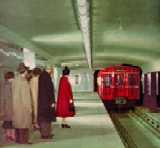
|
|
Gloucester Car pulls into Queen Station. Picture featured in the April 1954 edition of TTC’s Coupler Newsletter. |
While the TTC was interested in some aspects of this design, the Gloucester proposal was the most economical, and furthermore the Gloucester product was proven, having provided superior service and passenger comfort from the start. Following on the experience of the original Gloucesters, the TTC was wary of the extremely low weight estimate given. In addition, the CC & F cars would not be compatible with the existing Gloucester fleet, thus requiring additional spare parts and training for a different type of equipment, further increasing the cost. In June 1955, the TTC awarded Gloucester the contract for the 34 additional cars (designated the “G-3” class and numbered 5200-5233) at a total cost of $3,200,000 CAD.
The TTC was interested in the advantages of electro-dynamic braking, as brake shoe dust had been an ongoing problem with the original Gloucesters. Electro-dynamic braking would convert the output of the traction motors into energy which could slow the train down to nearly a stop, with electro-pneumatic braking only being used to bring the train to a full stop. The TTC wanted to evaluate this feature as a possibility for future subway car orders, and initiated discussions with Gloucester to equip some cars of the 34 car order with dynamic braking. Gloucester and its associated suppliers developed a proposal which would see dynamic braking installed on the last six cars of the 34 car order. The train would operate as a semi-permanently coupled unit, but could still be coupled to two existing cars to create a standard eight-car train.
By operating the train as six-cars in off-peak service, the full advantages of electro-dynamic braking could be evaluated. In case the dynamic brakes failed for any reason, the train could be stopped using the standard electro-pneumatic system. The benefits of dynamic braking included reduced brake shoe usage, reduced brake shoe dust, reduced wheel wear and lower energy consumption as the dynamic braking system could be used to heat the cars. In April 1956, the TTC approved the proposal, which would see two cars also outfitted with controls and couplers as the end cars. The additional cost amounted to $100,000 CAD but evaluating the benefits of the performance of dynamic braking was a top priority.
Further experimental features, such as Gloucester-designed “Metalastik” suspension and different designs for gearboxes and other components resulted in the delivery of the first two cars (the end cars, numbered 5228-5229) being delayed until 1958. The remaining non-driving cars (numbered 5111- 5114) were not delivered until early 1959. Due to the experimental nature of these cars, and coinciding with the beginning of the space age, these cars (designated “G-4” class) were nicknamed the “Sputniks” after the Soviet satellite. The six-car train was renumbered as 5110-5115 and operated successfully with the experimental equipment, paving the way for electro-dynamic braking to be standard equipment on all subsequent subway car orders in Toronto.
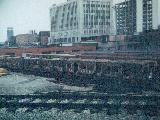
|
|
Burnt out Gloucesters at Davisville. Photo donated from the Brad O’Brien collection. |
The Gloucesters operated without incident until the night of March 27, 1963, when six cars were destroyed by fire. The six-car train, consisting of 5005-5204-5205-5004-5059-5058, arrived at Union Station with what was thought to be a minor fire under car 5205. The few remaining passengers were evacuated and the train was parked on the spare track, where it was consumed by flames. It took three hours to contain the fire in the narrow space of the spare track. The fire was so intense that the cars were completely gutted and the heat melted the aluminum roofs of 5204 and 5205 right through. Trucks and control equipment were salvaged and the car bodies were scrapped by the fall of 1963.
In the summer of 1965, the six-car “Sputnik” train was stored while new Hawker-Siddeley H-1 class subway cars were being broken in. The cars were then taken into the shops where the experimental equipment was removed and the cars reconfigured so that the end cars (5110 and 5115) operated as a two-car unit, while cars 5111-5114 were inserted between G-1 cars to form two additional four-car trainsets (5028-5113-5112-5029 and 5030-5111-5114-5031). The four middle cars were effectively converted to G-3 class cars while the end cars were the same as standard G-1 class cars.
In 1967, driving control equipment from G-1 cars 5033 and 5034 was removed for use on new work trains, and an additional four-car trainset was made from cars 5032-5033-5034-5035. In April 1967, a vandal-originated fire damaged car 5080, and as an experiment to brighten the interior of the Gloucester cars, 5080 and 5081 were refitted with fluorescent lighting, similar to that used on the TTC’s Montreal Locomotive Works cars. The fluorescent lighting did brighten the cars but no further retrofits were done. Another car, 5056, was fitted with light yellow wall panels, which also brightened the car interior. Between 1966 and 1973, all 134 remaining Gloucester cars were completely overhauled and repainted at the Greenwood Shops to continue providing reliable daily service.
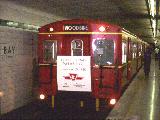
|
|
Coming to an end: G-Train pauses at Lower Bay Station during its retirement charter (photo by Alan Gryfe); a set, retired and stored in Vincent Yard is seriously vandalized (photo by Thomas Robinson). |
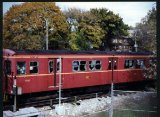
|
The Gloucesters would continue to provide extremely reliable service through the 1980s, when the TTC finally made plans to replace their slower and heavier workhorse subway cars. 126 H-6 class cars were ordered in December 1983, however due to engineering and production delays, they were not introduced into regular service until the fall of 1987. As the new cars were finally brought into service through 1988 and 1989, most of the Gloucesters were withdrawn and put into storage. Because of the reliability and robustness of the Gloucester equipment, the six aluminum G-2 cars were converted to three work trains for garbage collection, tunnel washing and rail grinding. Two steel G-1 cars (5068 and 5069) were also later converted to a rail grinding work train. By November 1989, only one Gloucester train was still operating in rush hour service. This last train was taken on a “farewell charter” by the Toronto Transportation Society on September 30, 1990, and made its last run in the morning of October 26, 1990, falling only five days short of its scheduled retirement.
As the Gloucesters were still in excellent condition, the city of Lima, Peru considered purchasing them for its new subway system. However, the deal was not completed, and most of the Gloucesters were eventually offered for sale for scrap, with the scrapping of most cars taking place at the Wilson Yard in March 1991.
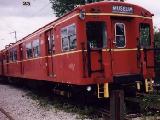
|
|
Cars 5098 and 5099 at the Halton County Radial Railway. |
Two cars (5098-5099, the last two of the original 100 cars) were donated to the Ontario Electric Railway Historical Association and preserved at the Halton County Radial Railway museum in Milton Ontario. Cars were also made available for a planned transportation museum in Gloucester, England, however nothing came of the plans and the museum never materialized. Two of the three G-2 work trains were retired by 1999, while the remaining two work trains, both used for rail grinding, continued to ply the tunnels of Toronto’s subway system fifty years after they began carrying Torontonians on Canada’s First Subway. By this time the two rail grinding trains were configured to each have one steel G-1 car and one aluminum G-2 car. Unfortunately one of the two rail grinding trains (involving cars RT34 and RT37) was involved in a collision later in 2004 and was not repaired. The second grinding train was made redundant by the introduction of rotary rail grinding provided by a more modern type of equipment, rented and used as needed. Rotary grinding equipment is much more efficient in restoring the correct profile of the rails than the traditional grinding stone technique. As a result, the last Gloucester rail grinding train (including cars RT35 and RT36) remained on standby duty until 2009 when it was finally retired and disposed of, bringing to a close the story of Toronto’s original subway cars.
Gloucesters Image Archive
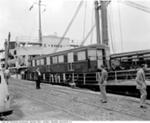
|
TTC Gloucester Car #5000 prepares to be unloaded from the docks in this early 1950s shot. This image is courtesy the Toronto Archives. |

|
Here, we see workers putting the finishing touches to a special station pavilion with Gloucester cars 5000 and 5001, to showcase the upcoming Yonge Subway at the Canadian National Exhibition in August 1953. The photograph is by James Victor Salmon and is courtesy the Toronto Archives. |
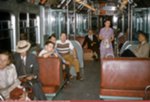
|
A shot of passengers inside a Gloucester train, possibly at Eglinton station, on July 5, 1954. Image courtesy Richard Glaze. |
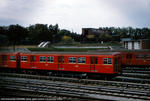
|
TTC Gloucester car #5048 and its mate #5049 wait to enter service at Davisville Yard on September 26, 1954. The photographer is unknown and the image is courtesy the John Knight collection. |
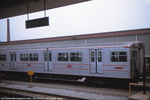
|
TTC aluminum Gloucester car #5104 rests at Davisville yard on May 13, 1956. The photographer is unknown, and the photo is from the John Knight collection. |
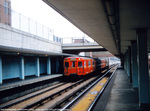
|
A train of Gloucester subway cars pulls into the northbound platform of Davisville station on May 13, 1956. The photographer is unknown and the image is from the John Knight collection. |

|
A train led by an aluminum Gloucester set approaches Davisville station on September 8, 1962. The photographer is unknown and the image is courtesy the Dave Shaw collection. |
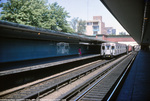
|
A six-car train of Gloucester-built subway cars, led by a pair of aluminum models, arrives at Rosedale station on July 4, 1968. The photographer is unknown. |
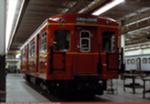
|
A single Gloucester car sits freshly repainted at Greenwood Shops in this April 1971 shot. The photographer is unknown and the image is courtesy the Charles Houser collection. |
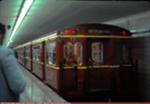
|
A train of Gloucester cars lays over at St. George station on July 6, 1974. The photographer is unknown and the image is courtesy the Charles Ebling collection. |
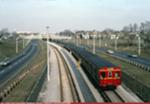
|
A Gloucester train heads northbound up the median of the Spadina Expressway on September 14, 1978, approaching Glencairn station. This photograph was taken by Bill Hood. |
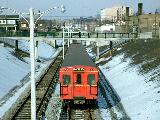
|
In the winter before the subway opened, a Gloucester train (used for training crews) heads north along the open cut south of Eglinton Station. The shot was taken from the Lola Road bridge, looking north toward the Manor Road footbridge. Photo by Julian Bernard, donated by Curt Frey. |

|
Gloucester car 5000, the first subway car, pauses at Wilson station the Spadina Subway line. The date of this photograph is unknown, but it was taken by Brad O'Brien. |
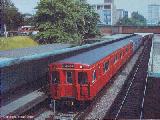
|
A Gloucester train enters Rosedale Station. Note the fishbowl serving the bus bay in the background. Photo donated by Brad O'Brien. |
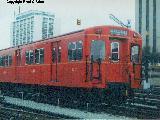
|
Gloucester train led by car 5098 waits outside at Davisville Yard in the late 1960s, early 1970s. Photo donated from the collection of Jim Blair. |
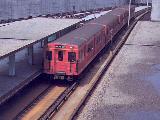
|
Gloucester subway car #5069 leads a four car train southbound into Davisville Station during the early days of the Yonge subway. Photo by Julian Bernard, donated from the collection of Curt Frey. |
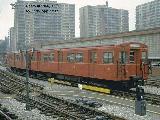
|
Jerry Appleman caught Gloucesters 5080 and 5081 at Davisville Yard in 1965. |
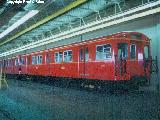
|
Gloucester train led by car 5092 rests indoors at the carhouse. Photo donated from the collection of Brad O'Brien. |
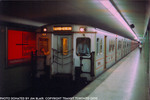
|
A six-car Gloucester subway train headed by a unit of G2 aluminum bodied cars at St. George station, prepares to head back to Eglinton in the early 1970's. Photo donated by Jim Blair. |
Related Articles:
- The Gloucester Series Retirement Charter, September 1990
- The Gloucester Garbage Train
- Aaron Adel’s The Garbage Train Movie
Now click here for a history of the Montreal series of subway cars.
Thanks to Ray Corley and Mark Brader for correcting this web page and offering additional information.
References
- Bromley, John F., and Jack May, Fifty Years of Progressive Transit, Electric Railroaders’ Association, New York (New York), 1978.
- Corley, Ray, Subway Car: 57 Foot Class G Cars, Toronto Transit Commission, Toronto (Ontario), February 1988.

